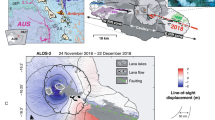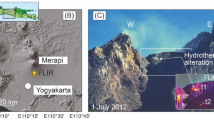Abstract
Hydrothermally altered rocks can weaken volcanoes, increasing the potential for catastrophic sector collapses that can lead to destructive debris flows1. Evaluating the hazards associated with such alteration is difficult because alteration has been mapped on few active volcanoes1,2,3,4 and the distribution and severity of subsurface alteration is largely unknown on any active volcano. At Mount Rainier volcano (Washington, USA), collapses of hydrothermally altered edifice flanks have generated numerous extensive debris flows5,6 and future collapses could threaten areas that are now densely populated7. Preliminary geological mapping and remote-sensing data indicated that exposed alteration is contained in a dyke-controlled belt trending east–west that passes through the volcano's summit3,4,5,8. But here we present helicopter-borne electromagnetic and magnetic data, combined with detailed geological mapping, to show that appreciable thicknesses of mostly buried hydrothermally altered rock lie mainly in the upper west flank of Mount Rainier. We identify this as the likely source for future large debris flows. But as negligible amounts of highly altered rock lie in the volcano's core, this might impede collapse retrogression and so limit the volumes and inundation areas of future debris flows. Our results demonstrate that high-resolution geophysical and geological observations can yield unprecedented views of the three-dimensional distribution of altered rock.
This is a preview of subscription content, access via your institution
Access options
Subscribe to this journal
Receive 51 print issues and online access
$199.00 per year
only $3.90 per issue
Buy this article
- Purchase on Springer Link
- Instant access to full article PDF
Prices may be subject to local taxes which are calculated during checkout


Similar content being viewed by others
References
Lopez, D. L. & Williams, S. N. Catastrophic volcanic collapse; relation to hydrothermal processes. Science 260, 1794–1796 (1993).
Frank, D. Surficial extent and conceptual model of hydrothermal system at Mount Rainier, Washington. J. Volcanol. Geotherm. Res. 65, 51–80 (1995).
Zimbelman, D. R. Hydrothermal Alteration and its Influence on Volcanic Hazards; Mount Rainier, Washington, a Case History (Univ. Colorado, Boulder, Colorado, 1996).
Crowley, J. K. & Zimbelman, D. R. Mapping hydrothermally altered rocks on Mount Rainier, Washington, with Airborne Visible/Infrared Imaging Spectrometer (AVIRIS) data. Geology 25, 559–562 (1997).
Crandell, D. R. & Waldron, H. H. A Recent volcanic mudflow of exceptional dimensions from Mount Rainier, Washington. Am. J. Sci. 254, 349–362 (1956).
Vallance, J. W. & Scott, K. M. The Osceola Mudflow from Mount Rainier: sedimentology and hazard implications of a huge clay-rich debris flow. Geol. Soc. Am. Bull. 109, 143–163 (1997).
Scott, K. M., Vallance, J. W. & Pringle, P. T. Sedimentology, behavior, and hazards of debris flows at Mount Rainier, Washington. US Geol. Surv. Prof. Pap. 1547, 1–56 (1995).
Moran, S. C., Zimbelman, D. R. & Malone, S. D. A model for the magmatic hydrothermal system at Mount Rainier, Washington, from seismic and geochemical observations. Bull. Volcanol. 61, 425–436 (2000).
Fiske, R. S., Hopson, C. A. & Waters, A. C. Geology of Mount Rainier National Park Washington. US Geol. Surv. Prof. Pap. 444, 93 (1963).
Sisson, T. W. & Lanphere, M. A. Geologic controls on the timing and location of flank alteration at Mt. Rainier, Washington. Eos 80, F1151–F1152 (1999).
Crandell, D. R. Postglacial lahars from Mount Rainier Volcano, Washington. US Geol. Surv. Prof. Pap. 677, 75 (1971).
Rystrom, V. L., Finn, Carol A. & Descsz-Pan, Maryla High resolution, low altitude aeromagnetic and electromagnetic survey of Mt Rainier. US Geological Survey Open-File Report 00-027 [online], 〈http://greenwood.cr.usgs.gov/pub/open-file-reports/ofr-00-0027/Rainierwebpage.html〉 (2000).
Deszcz-Pan, M., Fitterman, D. V. & Labson, V. F. Reduction of inversion errors in helicopter EM data using auxiliary information. Explor. Geophys. 29, 142–146 (1998).
Woodward, D. J. & Mumme, T. C. Variation of magnetisation on White Island, New Zealand. N.Z. J. Geol. Geophys. 36, 447–451 (1993).
Fiske, R. S., Hopson, C. A. & Waters, A. C. Geologic Map and Section of Mount Rainier National Park Washington (US Geological Survey Miscellaneous Investigations Series I-432, 1964).
Finn, C. & Williams, D. L. An aeromagnetic study of Mount St. Helens. J. Geophys. Res. 92, 10194–110206 (1987).
Williams, D. L. & Finn, C. A. Evidence for a shallow pluton beneath the Goat Rocks Wilderness, Washington, from gravity and magnetic data. J. Geophys. Res. 92, 4867–4880 (1987).
Reid, M. E., Christian, S. B., Brien, D. L. & Sisson, T. W. 3-D gravitational stability of stratovolcanoes. Eos 80, F1151 (1999).
Acknowledgements
We thank D. Fitterman, V. J. S. Grauch and P. Lipman for helpful reviews. This work was supported by the Mineral Resource and Volcano Hazards Programs of the US Geological Survey.
Author information
Authors and Affiliations
Corresponding author
Rights and permissions
About this article
Cite this article
Finn, C., Sisson, T. & Deszcz-Pan, M. Aerogeophysical measurements of collapse-prone hydrothermally altered zones at Mount Rainier volcano. Nature 409, 600–603 (2001). https://doi.org/10.1038/35054533
Received:
Accepted:
Issue Date:
DOI: https://doi.org/10.1038/35054533
This article is cited by
-
Long-term volcano evolution controlled by lateral collapse at Antuco volcano, southern Andes, Chile
Communications Earth & Environment (2023)
-
Lateral edifice collapse and volcanic debris avalanches: a post-1980 Mount St. Helens perspective
Bulletin of Volcanology (2023)
-
Airborne geophysical surveys of the lower Mississippi Valley demonstrate system-scale mapping of subsurface architecture
Communications Earth & Environment (2021)
-
Interpretation of high resolution aeromagnetic data for structures study and exploration of polymetallic deposits in Kalatage area, eastern Tianshan (NW China)
Geosciences Journal (2020)
-
Influence of alteration on the mechanical behaviour and failure mode of andesite: implications for shallow seismicity and volcano monitoring
Bulletin of Volcanology (2019)
Comments
By submitting a comment you agree to abide by our Terms and Community Guidelines. If you find something abusive or that does not comply with our terms or guidelines please flag it as inappropriate.



